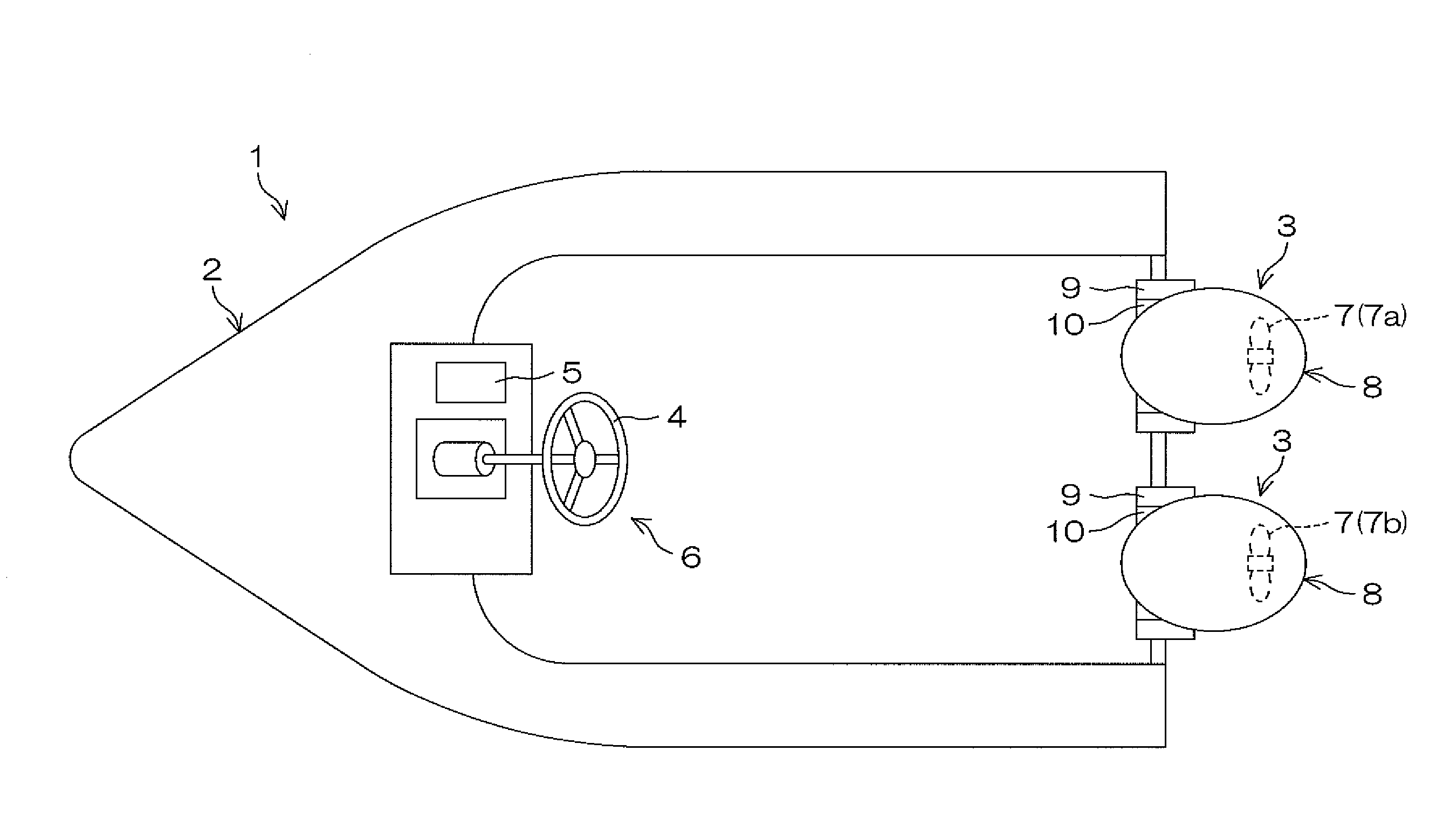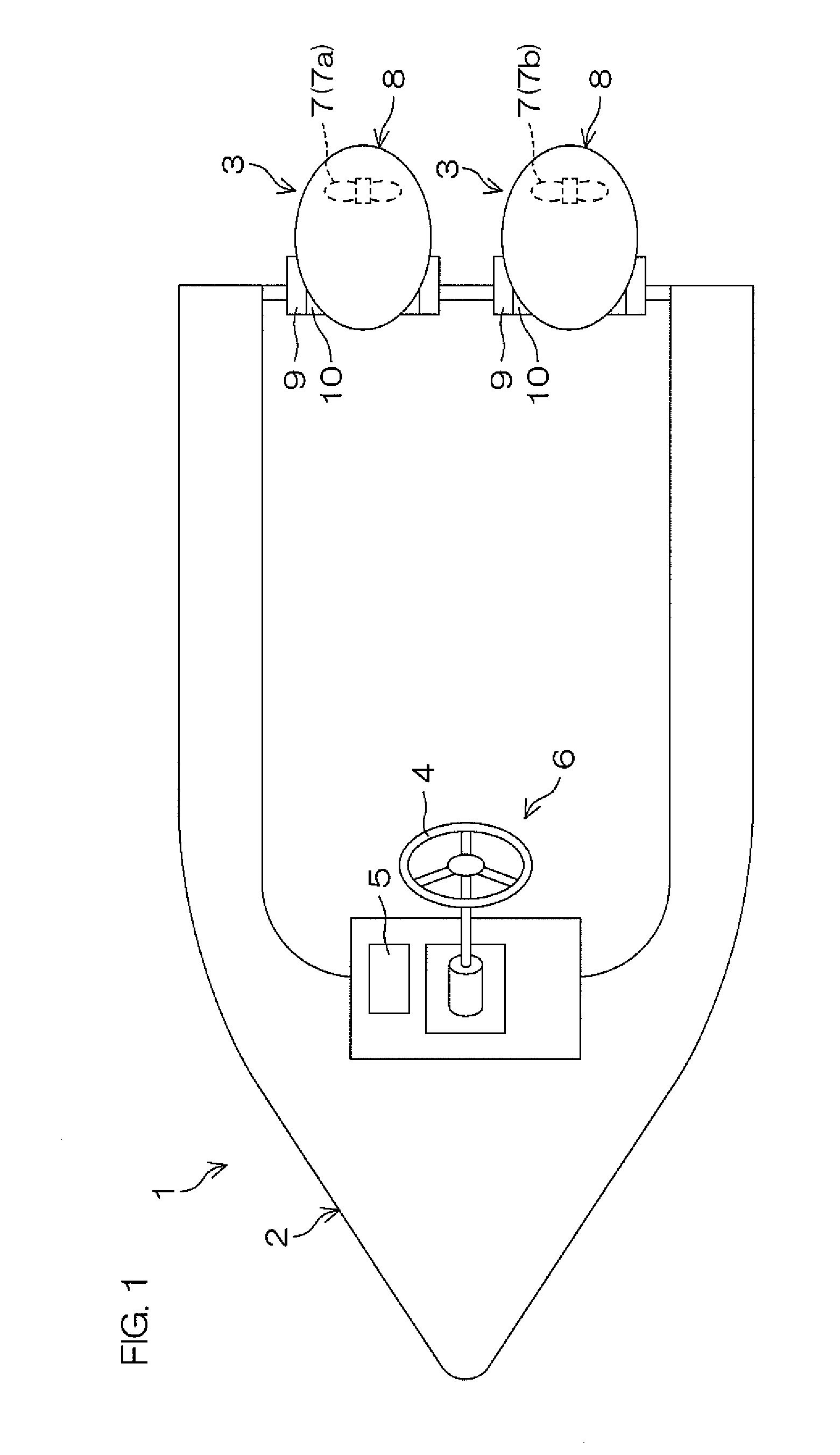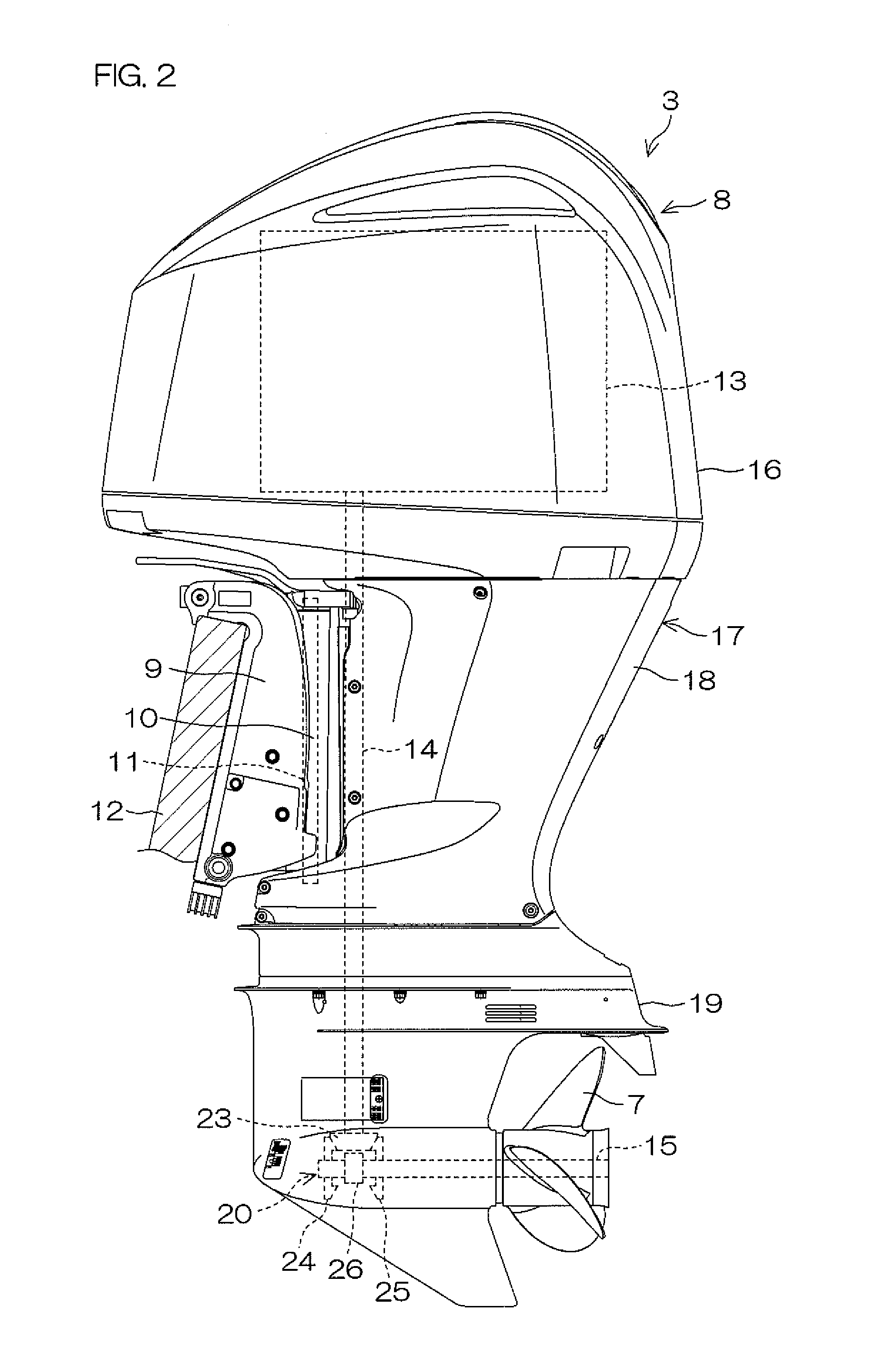[0013]FIG. 12 shows a state of a lower unit when the vessel travels forwardly with the normal-rotation vessel propulsion apparatus. As shown in FIG. 12, when the normal-rotation vessel propulsion apparatus generates a thrust in the forward direction, a dog clutch is engaged with a first gear serving as a forward gear (see the black arrow). As a result, the rotation of a drive shaft is transmitted to the dog clutch via a pinion and the first gear. A normal-rotation propeller rotates in a normal rotation direction together with the dog clutch and a propeller shaft. A thrust in the forward direction generated by the rotation of the propeller in the normal rotation direction is transmitted to the propeller shaft, a tapered roller bearing, a circlip, the first gear, an outer tapered roller bearing, and a lower case in this order (see the white arrow). On the other hand, a reaction force caused by the transmission of power from the pinion to the first gear is applied to the first gear at an engagement position of the pinion and the first gear (see the crosshatched arrow). As a result, a force by which the first gear is inclined is applied to the first gear. However, the position of the first gear is fixed by the transmission of a thrust in the forward direction to the first gear via the tapered roller bearing, and therefore the first gear will not be easily inclined even if a reaction force is applied to the first gear. Therefore, the engagement between the pinion and the first gear becomes stable, and a force greater than a designed, assumed value is prevented from being applied to the first gear.
[0017]FIG. 16 shows a state of the lower unit when the vessel travels forwardly with the reverse-rotation vessel propulsion apparatus. As shown in FIG. 16, when the reverse-rotation vessel propulsion apparatus generates a thrust in the forward direction, the second gear serving as a forward gear is engaged with the dog clutch (see the black arrow). As a result, the rotation of the drive shaft is transmitted to the dog clutch via the pinion and the second gear, and the reverse-rotation propeller rotates in the reverse rotation direction together with the dog clutch and the propeller shaft. In the reverse-rotation vessel propulsion apparatus, a thrust generated by the rotation of the propeller is transmitted via a flange attached to the propeller shaft. A thrust in the forward direction generated by the rotation of the propeller in the reverse rotation direction is transmitted to the propeller shaft, the tapered roller bearing, and the housing in this order (see the white arrow). On the other hand, a reaction force caused by the transmission of power from the pinion to the second gear is applied to the second gear at an engagement position of the pinion and the second gear (see the crosshatched arrow). The direction of the thrust applied to the tapered roller bearing via the propeller shaft is opposite to the direction of the reaction force applied to the tapered roller bearing via the second gear. However, the reaction force applied to the second gear is sufficiently smaller than the magnitude of the thrust applied in the forward direction, and therefore the axial center of the tapered roller bearing becomes stable, and the position of the second gear is fixed. Therefore, the second gear is restrained from being inclined or being moved in the axial direction.
[0021]As described above, there is a possibility that the displacement of gears, i.e., the inclination or movement in the axial direction of gears will occur, and the durability of these gears will be decreased if the vessel propulsion apparatus having one of the two different kinds of specifications is used according to the other of the two different kinds of specifications. For example, it is conceivable that a decrease in durability of gears can be prevented if the gears are enlarged. However, if the gears are enlarged, the lower unit of the vessel propulsion apparatus is enlarged, and, as a result, the resistance of water is increased. Therefore, it is preferable to decrease the amount of displacement of each gear as much as possible without enlarging the lower unit of the vessel propulsion apparatus.
[0027]As described above, a preload is applied onto the first bearing that rotatably supports the first driven gear and onto the second bearing that rotatably supports the second driven gear, and therefore an internal gap of the first bearing and that of the second bearing can be removed, and the position of the first driven gear and that of the second driven gear can be fixed. In other words, the first driven gear and the second driven gear can be held so as not to perform an operation other than rotation. Therefore, the engagement between the drive gear and each gear (i.e., each of the first and second driven gears) can be prevented from becoming unstable even when the vessel propulsion apparatus is used according to either normal or reverse rotation specifications. This makes it possible to prevent the durability of the gears from being decreased. Therefore, the vessel propulsion apparatus can be used according to either normal or reverse rotation specifications.
[0028]The position of each of the first and second gears can be fixed, and the vessel propulsion apparatus can be used according to either normal or reverse rotation specifications as described above, and therefore there is no need to provide special or unique components exclusively for use in each of the two different kinds of specifications. Therefore, it is possible to reduce the production costs and the number of development man-hours of the vessel propulsion apparatus. Additionally, the retail outlet of the vessel propulsion apparatus has no need to stock special or unique components as spare components used for repairs for each of the specifications. Moreover, the first and second bearings and the first and second driven gears can remove their backlashes by applying a preload onto the first and second bearings, and therefore it is possible to prevent the occurrence of an abnormal noise caused by these backlashes.
 Login to View More
Login to View More  Login to View More
Login to View More 


